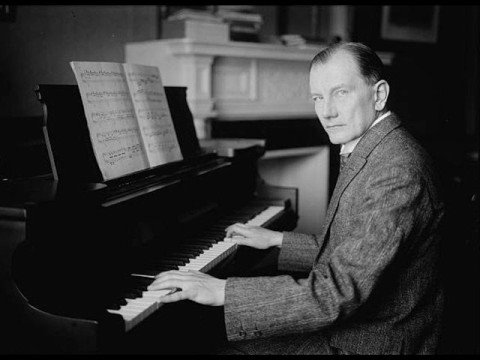Ernö Dohnányi (1877-1960)
Variations on a Nursery Theme Op. 25 for full orchestra and piano concertante
Composed Berlin 1914
Instrumentation: 2 flutes and piccolo, 2 oboes, 2 clarinets, 2 bassoons, contrabassoon, 4 horns, 2 trumpets, 3 trombones, timpani, and strings
Background
Hungarian pianist, conductor, teacher and composer Ernö Dohnányi (Ernst von Dohnányi) studied at the Royal Academy, Budapest and later became its director in 1934. As an accomplished pianist he toured extensively. In 1920 he performed the complete works of Beethoven and later all of Mozart’s piano concertos. In 1908, he became professor of piano at the Berlin Hochshule. He was permanent conductor of the Budapest Philharmonic Orchestra from 1919 to 1944 and in 1931 music director of the Hungarian State Radio. After World War II Dohnányi moved to the United States and taught at Florida State until his death in 1960. He is the grandfather of conductor Christoph von Dohnányi, 1929–, who was music director of the Cleveland Orchestra (1984–2002).
Dohnányi ‘s music is quite different from his fellow countrymen Béla Bartók and Zoltán Kodály in that Hungarian folk music was not as strong an influence on his work. However, this did not prevent Bartók from declaring, “You can sum up Hungarian music in one word, Dohnányi.” He did not turn his back completely on folk music. His [amazon text=Ruralia hungarica&asin=B000BYNEVC] (1924) was indeed based on Hungarian folk tunes. Later he became interested in American folk music. His last orchestral work,
[amazon text=American Rhapsody&asin=B000BYNEVC] (1953), utilizes folk material which includes “On Top of Old Smokey.”
His musical language has a solidly late romantic Germanic flavor that recalls Brahms and classical forms and continues the line of composing with the brilliance of orchestra color displayed by Richard Strauss and Erich Korngold.
The sections of [amazon text=Variations on a Nursery Theme&asin=B00000J8QW] are an Introduction, the Theme, eleven Variations and a Coda. The portentous introduction, reminiscent of Wagner in musical language, bombast and orchestration, actually outlines the theme in the horns.
Following the introduction that utilizes the sonority of the full orchestra, a well known nursery song (certain to cause headaches for any parents of Suzuki string students) is simply stated in its entirety by the piano.
Throughout this charming but very difficult work are allusions to many works by other composers. Sometimes the allusions are techniques such as the use of whole tones recalling Debussy, perhaps tiny inconspicuous quotations such as that from the Donna Diana Overture by Reznicek (the theme from 1950’s TV western Sergeant Preston of the Yukon), orchestrations similar to Wagner and Strauss, or a reference to Brahms’ Fourth Symphony in the passacaglia variation (no surprise there!). Part of the fun in listening to this piece is trying to identify his references (is that Brahms’ Second Piano Concerto here? Tchaikovsky’s Second Symphony there?).
All of this could deteriorate into mere gimmickry were it not for Dohnányi’s gifts as a composer and pianist. Perhaps aware that some critics would not “get it,” Dohnányi inscribed the score to this work “To the enjoyment of friends of humor, to the annoyance of others.”
Resources
[amazon template=iframe image&asin=B000BYNEVC][amazon template=iframe image&asin=B00000J8QW]
[amazon template=iframe image&asin=B0000CV5Z8][amazon template=iframe image&asin=B001OEW392][amazon template=iframe image&asin=B000PNFX9A][amazon template=iframe image&asin=B0000CV5Z6]
